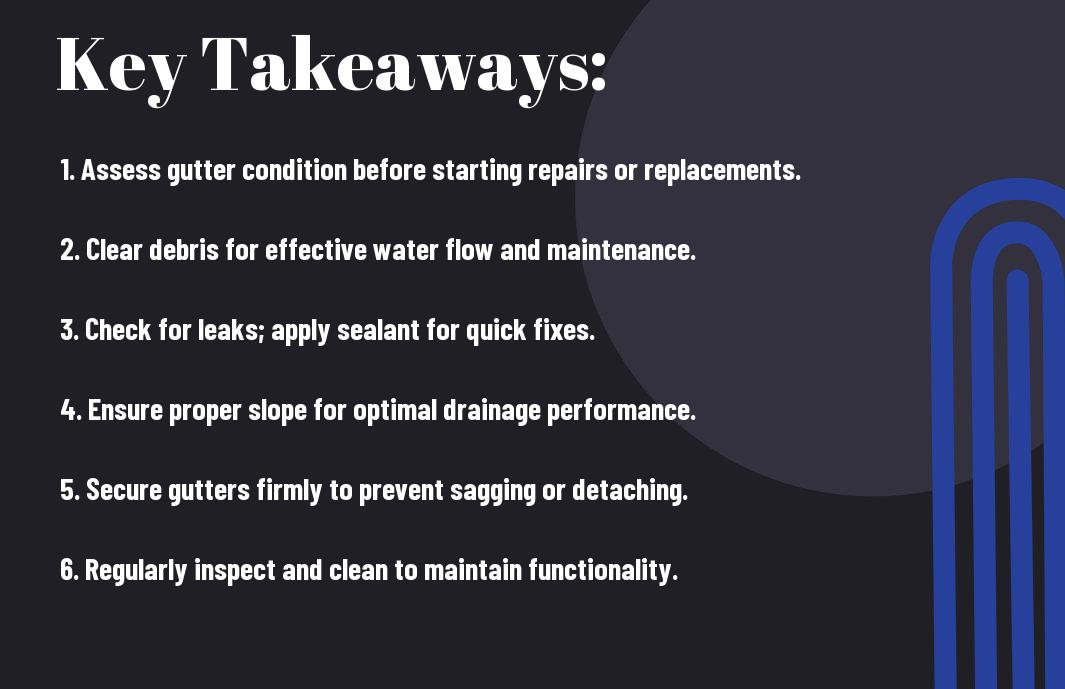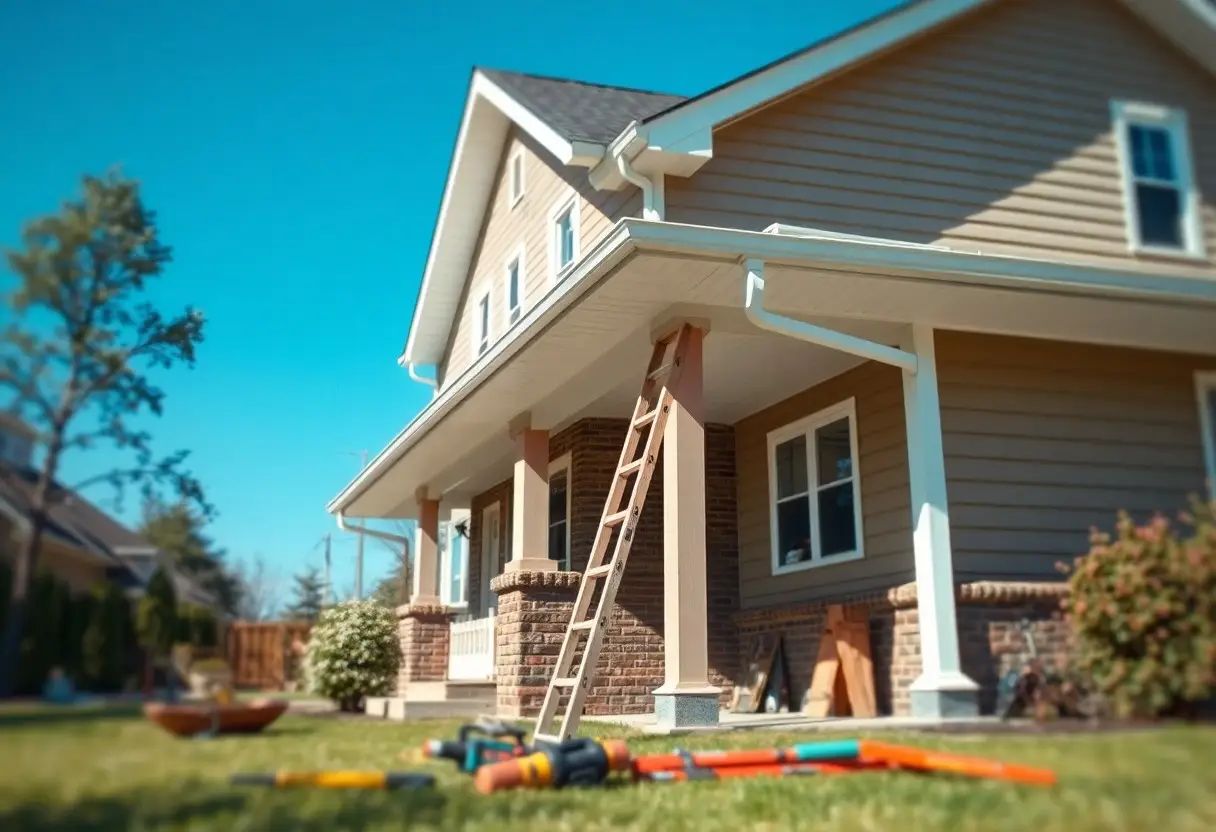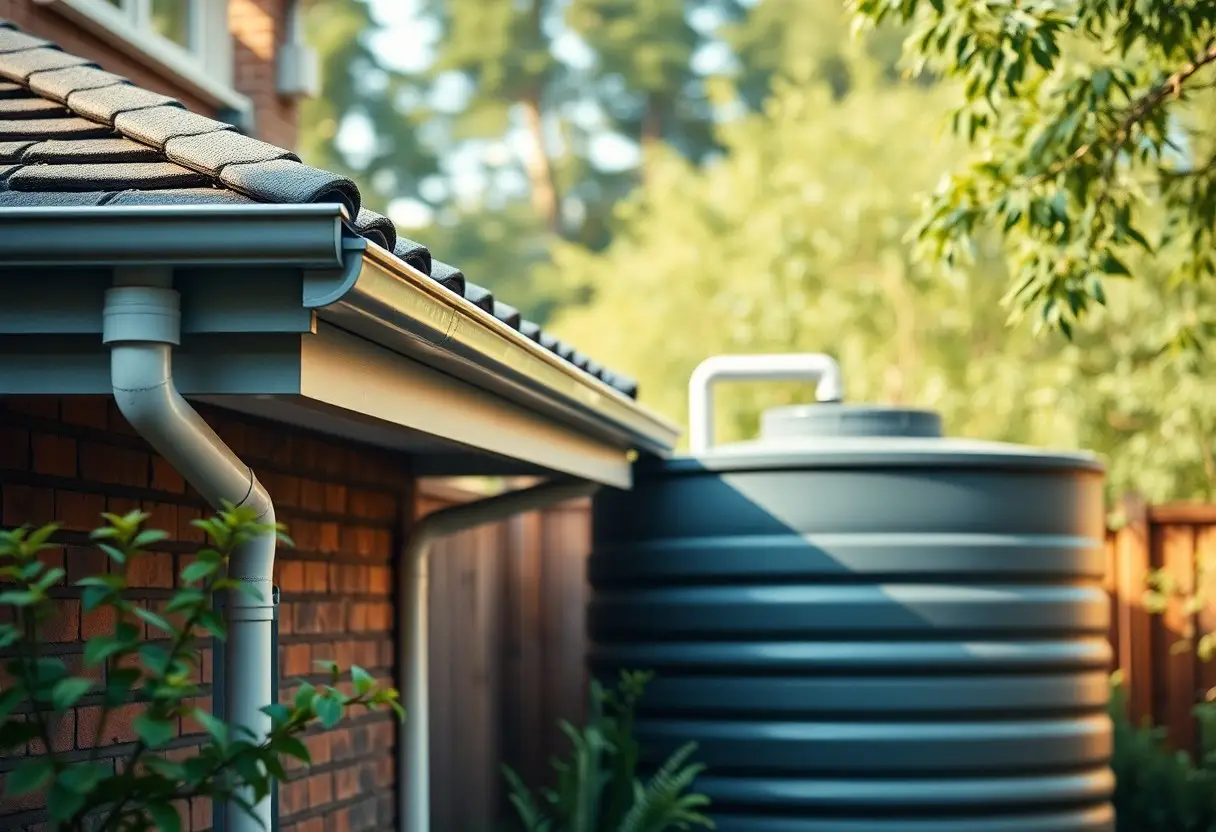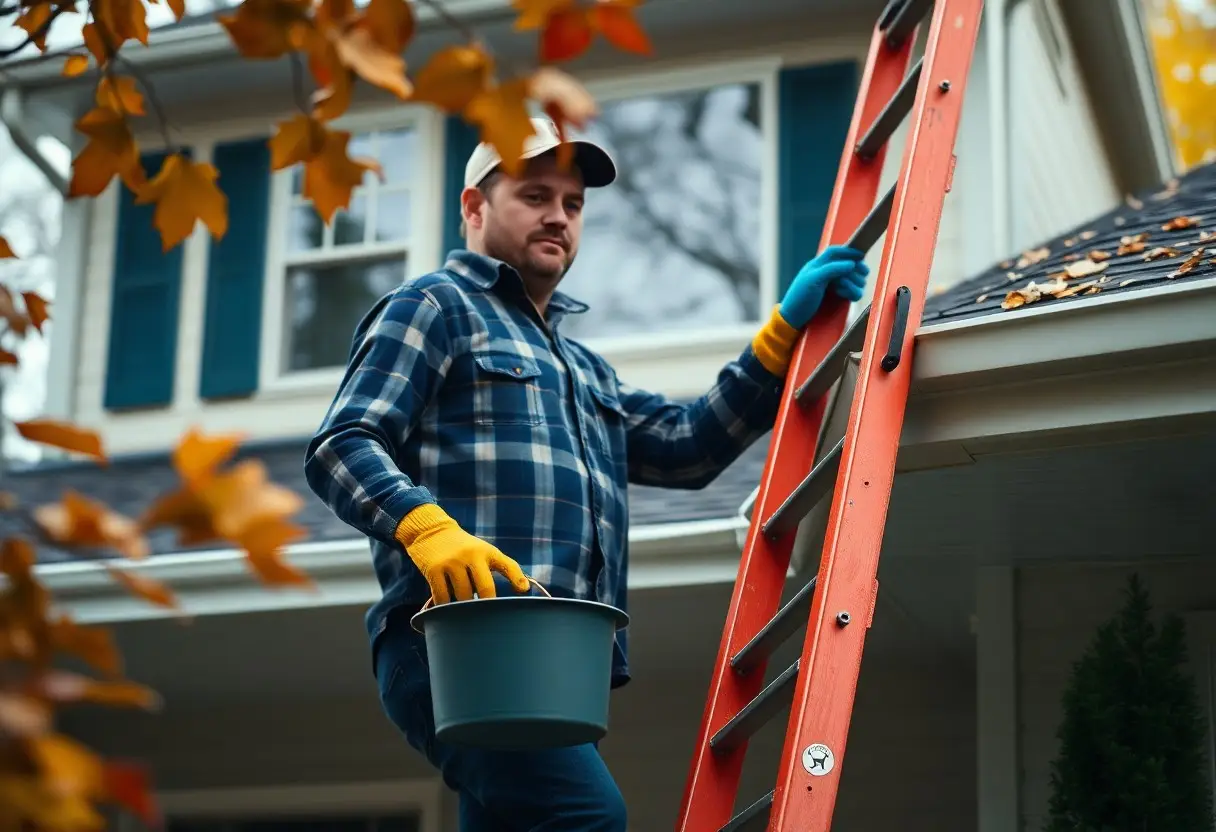Transform your home’s protection by mastering expert gutter repair. Your gutters play a vital role in directing rainwater away from your home, preventing water damage and other serious issues. In this post, you will discover 6 important steps that empower you to tackle gutter repairs like a pro. By following these guidelines, you will not only enhance the longevity of your gutters but also improve your home’s overall aesthetic appeal. Let’s examine the steps you need to take to keep your home safe and stylish!
Key Takeaways:
- Regular maintenance and inspection of gutters can prevent costly repairs and water damage to your home.
- Utilizing the right tools and materials is vital for effective gutter repair, ensuring durability and performance.
- Follow a systematic approach by assessing the problem, removing debris, repairing damage, and ensuring proper drainage to achieve the best results.
Understanding Gutter Systems
The effectiveness of your home’s drainage relies on a well-functioning gutter system. Each component plays a vital role in directing rainwater away from your foundation, preventing damage and prolonging your home’s lifespan. By understanding how these systems work, you can better maintain them and make informed decisions regarding repairs or replacements.
Types of Gutters
The different types of gutters cater to various architectural styles and homeowner preferences. Here’s a summary:
| Type | Description |
| K-Style | Popular choice with flat bottoms and semi-rectangular shapes. |
| Half-Round | Classic design with a curved shape, often used in historic homes. |
| Box Gutters | Built into the roof, providing a seamless appearance. |
| Fascia Gutters | Mounted to the fascia board, integrating design and function. |
| Seamless Gutters | Custom-made on-site, reducing leaks and maintenance needs. |
After understanding the different types, you’ll be better equipped to choose the right gutter for your home.
Common Gutter Issues
Above all aspects of gutter maintenance, being aware of common issues can save you from significant headaches later. Clogs, leaks, and sagging can jeopardize the performance of your system while leading to severe home damage.
Gutter clogs from leaves and debris can prevent water flow, causing overflowing that may lead to foundation damage and even mold growth. Leaks at joints or seams could also significantly impact the gutter’s ability to function properly, resulting in water damage to your eaves and walls. Additionally, sagging gutters create pools of water that increase the risk of corrosion and eventual failure. Recognizing these issues early on allows you to take preventative measures and maintain a healthy gutter system for your home.

Tools and Materials Needed
Some important tools and materials are necessary for an effective gutter repair project. Gathering these beforehand will make the process smoother and more efficient. You’ll need to invest in high-quality items that will stand the test of time, ensuring that your gutters not only function well but also maintain their appearance. Let’s examine the important tools and quality materials you should consider for your gutter repair journey.
Essential Tools for Gutter Repair
Materials for gutter repair include a ladder, safety goggles, gloves, a trowel, and a caulking gun. These tools will enable you to effectively clean, repair, and maintain your gutters. Investing time in gathering the right tools will undoubtedly save you hassle later on during the repair process while keeping you safe as you work.
Quality Materials for Longevity
On your journey toward effective gutter repair, selecting durable materials is vital for ensuring the longevity of your repairs. Opt for high-quality sealants, rust-resistant metals, and robust hangers to prevent future issues. By prioritizing quality, you are not only enhancing the reliability of your gutters but also protecting your home from costly water damage.
Plus, using premium materials directly impacts the durability of your repair work. Investing in rust-resistant metals and high-quality sealants ensures your gutters withstand harsh weather conditions that can lead to wear and tear. Also, using quality hangers will help maintain the structure and alignment of your gutter system, minimizing the risk of sagging or detachment. By selecting the best materials, you can significantly reduce the frequency of repairs needed, ultimately saving you time and money in the long run.

Step-by-Step Gutter Inspection
Your gutter system needs regular inspections to function effectively. Start by inspecting your gutters for blockages, leaks, and dents. Use a step-by-step approach for a thorough analysis, which will help you identify any potential problems early on. Below is a simple guide to assist you in your inspection process.
| Step | Action |
| 1 | Clear debris from your gutters. |
| 2 | Check for sagging sections. |
| 3 | Inspect for signs of leaks. |
| 4 | Ensure downspouts are functioning properly. |
| 5 | Look for rust or corrosion. |
| 6 | Assess gutter attachments and supports. |
Safety Precautions
Precautions must be your top priority during a gutter inspection. Always use a sturdy ladder and have a partner if possible, ensuring it’s placed on stable ground for added safety. Wear gloves to protect your hands from sharp debris and wear safety glasses to guard against falling particles.
Identifying Damage Signs
Precautions taken to observe your gutters can help you identify any damage signs effectively. Look for any cracks, rust, or holes in the metal that can lead to water leaks. Additionally, check for standing water; if you see it, it often indicates a serious blockage or improper slopes which require correction.
Inspection of your gutters should focus on visible damage signs like cracks and rust while also monitoring water flow during rain. Standing water is a major indicator of underlying issues; therefore, you should address any obstructions promptly. Also, ensure the gutters are securely fastened to avoid separation, which can lead to serious gutter failure. Through careful observation, you can maintain an effective gutter system that protects your home.
Repair Techniques
Now that you understand the importance of maintaining your gutters, it’s time to explore effective repair techniques. Depending on the condition of your gutters, you may need to seal leaks or even replace entire sections. This guide will provide you with the necessary steps and tips to ensure your gutter system functions effectively, preventing potential water damage to your home. Follow these techniques to keep your gutters in top shape!
Sealing Leaks
Between your gutter sections and downspouts, leaks can develop over time due to wear, damage, or debris buildup. To seal these leaks, you can apply a high-quality gutter sealant or silicone caulk. Make sure to clean the area thoroughly before sealing to ensure a strong bond. A well-sealed gutter will effectively divert rainwater away from your home’s foundation, protecting against water damage.
Replacing Gutter Sections
Below your gutter system may have sections that are severely damaged or rusted, necessitating replacement. It’s important to assess if a complete section replacement is required as this can greatly improve the performance of your gutter system.
Due to factors such as age, weather exposure, and lack of maintenance, sections of your gutter may suffer from significant deterioration. Replacing these sections promptly is vital as damaged gutters can lead to serious water damage and even foundation problems. Take care to select the same material and size when replacing sections, making sure to secure them properly. This not only enhances performance but also keeps your outdoor aesthetics appealing, minimizing potential hazards from overflowing water. Invest your time in replacement to ensure longevity and effectiveness in your gutter system.
How Can Long-Lasting Gutter Repair Solutions Enhance My Home Transformation?
Transforming your home starts with a solid foundation, and effective gutter maintenance is crucial. Investing in longlasting solutions for gutter repair not only enhances your home’s aesthetic appeal but also prevents water damage. These solutions ensure that rainwater is properly diverted, protecting your home’s structure and landscaping for years to come.
Preventive Maintenance Tips
All homeowners should prioritize their gutters’ health by implementing a robust preventive maintenance plan. Here are some tips to help you maintain your gutters in excellent condition:
- Schedule regular cleanings to avoid clogs
- Inspect for leaks and damage after heavy rainfall
- Use appropriate gutter guards to reduce debris buildup
- Trim overhanging branches to prevent leaves from entering
- Check that downspouts are clear and directing water away
Any effort you put into maintenance will pay off in improved gutter performance.
Regular Cleaning Schedule
With a proper cleaning schedule, you can prevent the buildup of leaves and debris in your gutters. Aim to clean your gutters at least twice a year, preferably in spring and fall, to ensure they function optimally.
Seasonal Inspections
Preventive inspections should be conducted seasonally to catch potential issues early. You should visually check for any signs of damage or wear and tear, especially after storms, to keep your gutters performing well.
Also, pay attention to any areas where water spills over the sides of the gutters, as this may indicate blockages or inadequacies in your current system. Check for rust, cracks, or sagging sections, which could lead to serious structural damage if not addressed. By being proactive about these inspections, you can save yourself from costly repairs and ensure that your home remains protected from water damage.
Summing up
On the whole, transforming your home through expert gutter repair involves understanding the importance of your gutters and following a structured approach. By assessing the current condition, gathering the right tools, cleaning debris, repairing or replacing damaged sections, ensuring proper alignment, and performing regular maintenance, you can enhance the functionality of your gutter system. This proactive approach not only protects your home from water damage but also contributes to its overall value. Taking these steps empowers you to maintain a healthy and efficient home environment.
Q: What are the first steps to take when preparing for a gutter repair?
A: Before beginning your gutter repair project, start by assessing the condition of your gutters. Inspect for any visible signs of damage, such as cracks, rust, or sagging sections. Gather your necessary tools and materials, which typically include a ladder, a caulking gun, gutter sealant, and replacement parts if needed. Additionally, ensure you have safety equipment like gloves and goggles. It’s also wise to check the weather forecast to choose a dry day for repair, ensuring the best working conditions.
Q: How do I effectively clean gutters before performing repairs?
A: Cleaning your gutters is an crucial step in the repair process. Begin by removing debris such as leaves, twigs, and dirt using a scoop or your hands while wearing gloves. It’s advisable to use a bucket or a tarp placed under the gutter to collect waste and minimize mess. After the bulk of debris is cleared, flush the gutters with water from a garden hose to remove smaller particles and to check for blockages in downspouts. If any clogs are detected, use a plumber’s snake or a similar tool to clear them. Ensuring your gutters are clean will allow for more effective repairs and a clearer view of what needs fixing.
Q: What should I do if I find damaged sections of gutter during my repair?
A: If you encounter damaged areas while inspecting your gutters, your course of action will depend on the severity of the damage. For small cracks, you can often use a gutter sealant to patch them up. Clean the area thoroughly and apply the sealant according to the manufacturer’s instructions. For more extensive damage, such as large holes or sections that are rusted through, it may be necessary to replace that portion of the gutter. Cut out the damaged section and attach a new piece using screws and sealant to ensure a watertight fit. After repair, test the section with water to ensure proper flow before moving on.


